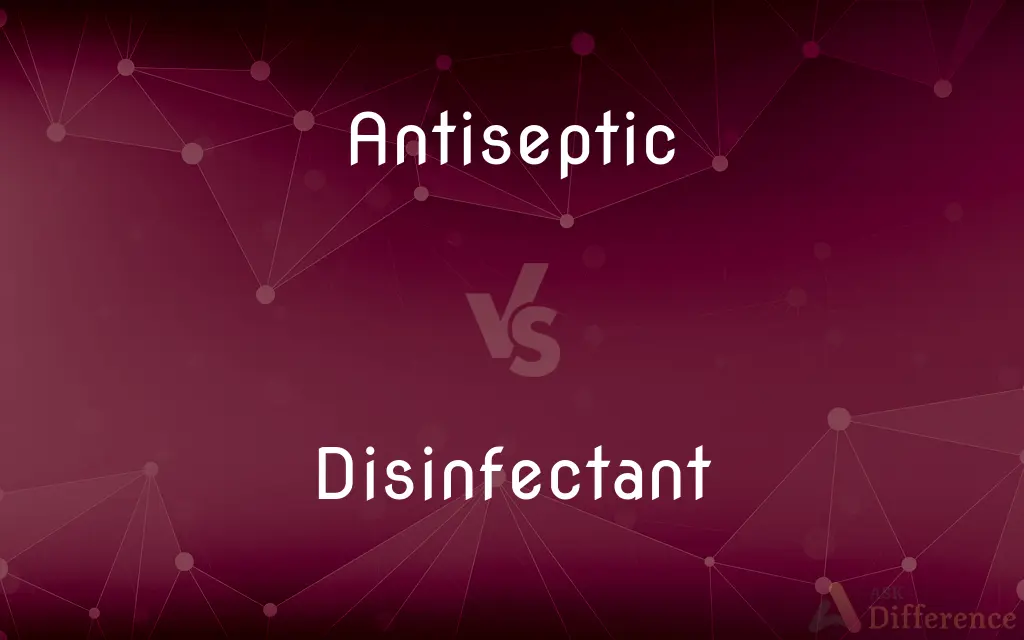Antiseptic vs. Disinfectant — What's the Difference?
Edited by Tayyaba Rehman — By Urooj Arif — Updated on March 21, 2024
Antiseptics are used on living tissues to prevent infection, while disinfectants are used on surfaces to kill microbes.

Difference Between Antiseptic and Disinfectant
Table of Contents
ADVERTISEMENT
Key Differences
Antiseptics are substances that prevent the growth of disease-causing microorganisms on living tissues, such as skin, wounds, and mucous membranes. Disinfectants, on the other hand, are chemicals used to kill or inhibit the growth of microbes on inanimate objects and surfaces.
While antiseptics are formulated to be safe for application on or in the human body, disinfectants are often too harsh for direct human contact and are used on surfaces like countertops, floors, and medical equipment.
The concentration of active ingredients often differs between antiseptics and disinfectants, with antiseptics being milder to prevent damage to living tissues. Disinfectants, conversely, may contain higher concentrations of biocidal agents to effectively kill germs on surfaces.
Antiseptics may include alcohol, iodine, and hydrogen peroxide, which are used in lower concentrations to avoid tissue damage. Disinfectants can include similar substances but at higher concentrations, as well as other chemicals like bleach and quaternary ammonium compounds, which are not safe for use on the skin.
The purpose of using antiseptics is to reduce the risk of infection in cuts, burns, and surgical sites, whereas disinfectants aim to sterilize environments to prevent the spread of diseases, especially in hospitals, schools, and public spaces.
ADVERTISEMENT
Comparison Chart
Usage
On living tissues (skin, wounds)
On inanimate objects (surfaces, equipment)
Objective
Prevent infection
Kill microbes
Safety
Safe for use on or in the human body
Often too harsh for direct human contact
Active Ingredients
Milder concentrations
Higher concentrations
Examples
Alcohol, iodine, hydrogen peroxide
Bleach, quaternary ammonium compounds
Compare with Definitions
Antiseptic
Formulated for Safety on Skin.
Hydrogen peroxide is used to clean wounds without harming tissue.
Disinfectant
Kills Microbes on Surfaces.
Bleach solutions are used to sanitize kitchen countertops.
Antiseptic
Contains Milder Concentrations.
Iodine solutions are diluted for safe application on mucous membranes.
Disinfectant
Not Safe for Direct Skin Contact.
Using a surface disinfectant on skin can cause irritation or damage.
Antiseptic
Used in Healthcare and Personal Care.
Hand sanitizers act as antiseptics to reduce microbial presence.
Disinfectant
Prevents Disease Spread.
Disinfecting door handles can reduce the transmission of viruses.
Antiseptic
Prevents Infection on Living Tissues.
Using alcohol on a cut helps prevent infection.
Disinfectant
Contains Harsher Chemicals.
Industrial disinfectants can kill a broad spectrum of germs.
Antiseptic
Helps in Healing Process.
Antiseptic creams support the body's natural healing of skin abrasions.
Disinfectant
Crucial for Infection Control in Facilities.
Hospitals use disinfectants to sterilize rooms and equipment.
Antiseptic
An antiseptic (from Greek ἀντί anti, "against" and σηπτικός sēptikos, "putrefactive") is an antimicrobial substance or compound that is applied to living tissue/skin to reduce the possibility of infection, sepsis, or putrefaction. Antiseptics are generally distinguished from antibiotics by the latter's ability to safely destroy bacteria within the body, and from disinfectants, which destroy microorganisms found on non-living objects.Antibacterials include antiseptics that have the proven ability to act against bacteria.
Disinfectant
A disinfectant is a chemical substance or compound used to inactivate or destroy microorganisms on inert surfaces. Disinfection does not necessarily kill all microorganisms, especially resistant bacterial spores; it is less effective than sterilization, which is an extreme physical or chemical process that kills all types of life.
Antiseptic
Capable of preventing infection by inhibiting the growth of infectious agents.
Disinfectant
A chemical liquid that destroys bacteria
All surfaces are cleaned manually or by pressure washer with disinfectant
A cat won't use its litter box if it's cleaned with smelly disinfectants
Antiseptic
Devoid of infectious agents; aseptic.
Disinfectant
Causing disinfection
Cleansing and disinfectant products
Antiseptic
Of or associated with the use of antiseptics.
Disinfectant
An agent, such as heat, radiation, or a chemical, that is applied to inanimate objects to destroy, neutralize, or inhibit the growth of disease-carrying microorganisms.
Antiseptic
Devoid of enlivening or enriching qualities
"This is ... not at all lighthearted or amiable music. In fact, the tone is unremittingly sober and antiseptic" (Donal Henahan).
Disinfectant
Serving to disinfect.
Antiseptic
Free of disturbing or unpleasant features; sanitized
An antiseptic version of history.
Disinfectant
Serving to kill germs or viruses.
I washed repeatedly with a disinfectant soap but I still caught the flu.
Antiseptic
A substance that prevents infection by inhibiting the growth of infectious agents.
Disinfectant
A substance that kills germs and/or viruses.
The scalpels were soaked in disinfectant before the operation so disease wouldn't be spread.
Antiseptic
Of, or relating to antisepsis, or the use of antiseptics.
Disinfectant
That which disinfects, especially an agent for killing or removing the microorganisms which cause infection. Commonly used disinfectants are chlorine, sodium hypochlorite solution, hydrogen peroxide, and alcohol.
Antiseptic
(pharmaceutical effect) Capable of preventing microbial infection.
Disinfectant
An agent (as heat or radiation or a chemical) that destroys microorganisms that might carry disease
Antiseptic
Very clean; aseptic.
Disinfectant
Preventing infection by inhibiting the growth or action of microorganisms
Antiseptic
Free of unpleasantness; prim, sanitized or bowdlerized.
Antiseptic
(pharmaceutical drug) Any substance that inhibits the growth and reproduction of microorganisms. Generally includes only those that are used on living objects (as opposed to disinfectants) and aren't transported by the lymphatic system to destroy bacteria in the body (as opposed to antibiotics).
Antiseptic
Counteracting or preventing putrefaction, or a putrescent tendency in the system; antiputrefactive.
Antiseptic
A substance which kills or retards the growth of microorganisms, especially when used for protection against infection; a substance which prevents or retards putrefaction, or destroys, or protects from, putrefactive organisms; as, carbolic acid, alcohol, cinchona, and many other agents sold commercially.
Antiseptic
A substance that destroys micro-organisms that carry disease without harming body tissues
Antiseptic
Thoroughly clean and free of or destructive to disease-causing organisms;
Doctors in antiseptic green coats
The antiseptic effect of alcohol
It is said that marjoram has antiseptic qualities
Antiseptic
Clean and honest;
Antiseptic financial practices
Antiseptic
Freeing from error or corruption;
The antiseptic effect of sturdy criticism
Antiseptic
Made free from live bacteria or other microorganisms;
Sterilized instruments
Antiseptic
(extended sense) of exceptionally clean language;
Lyrics as antiseptic as Sunday School
Common Curiosities
Can antiseptics kill bacteria?
Yes, they can inhibit the growth or kill bacteria on living tissues.
What is an antiseptic?
Antiseptics are substances applied to living tissues to prevent microbial infection.
Can I use a disinfectant on a wound?
No, disinfectants are too harsh for living tissues and can cause damage.
How do antiseptics work?
They work by destroying or inhibiting the growth of microorganisms on the tissue.
Are there natural antiseptics?
Yes, substances like tea tree oil and honey have antiseptic properties.
What's the difference between an antiseptic and a sanitizer?
Antiseptics are used on the skin, while sanitizers are generally used to clean objects, though hand sanitizers are a form of antiseptic.
How often should I use an antiseptic on a wound?
Follow the product's instructions or a healthcare professional's advice to avoid overuse, which can delay healing.
Are antiseptics safe for all skin types?
While generally safe, some individuals may have allergies or sensitivities to specific antiseptics.
Can I use an antiseptic as a disinfectant?
While some antiseptics can be used on surfaces, they are usually not as strong as disinfectants.
What is a disinfectant used for?
Disinfectants are used to kill or inhibit microbes on inanimate objects and surfaces.
Why are disinfectants not safe for human skin?
They contain harsh chemicals that can cause skin irritation, damage, or allergic reactions.
Is it necessary to use a disinfectant daily?
The frequency depends on the area and exposure risk. High-touch areas in public spaces may require more frequent disinfection.
Do disinfectants work immediately?
Disinfectants require a certain amount of contact time to be effective, which varies by product.
What are common ingredients in antiseptics?
Common ingredients include alcohol, iodine, and chlorhexidine.
Can overuse of antiseptics lead to resistance?
Overuse of some antiseptics may contribute to antimicrobial resistance, though the risk varies with the type of antiseptic.
Share Your Discovery

Previous Comparison
Leftard vs. Rightard
Next Comparison
Chatbox vs. ChatbotAuthor Spotlight
Written by
Urooj ArifUrooj is a skilled content writer at Ask Difference, known for her exceptional ability to simplify complex topics into engaging and informative content. With a passion for research and a flair for clear, concise writing, she consistently delivers articles that resonate with our diverse audience.
Edited by
Tayyaba RehmanTayyaba Rehman is a distinguished writer, currently serving as a primary contributor to askdifference.com. As a researcher in semantics and etymology, Tayyaba's passion for the complexity of languages and their distinctions has found a perfect home on the platform. Tayyaba delves into the intricacies of language, distinguishing between commonly confused words and phrases, thereby providing clarity for readers worldwide.














































